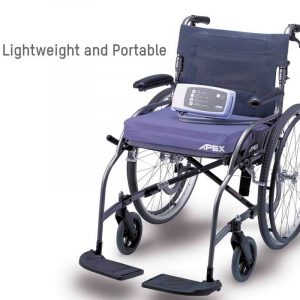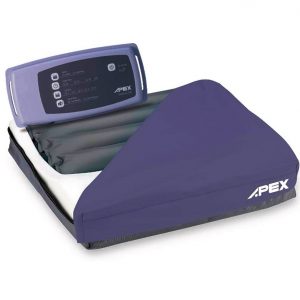- Sorry, this product cannot be purchased.
Active Seat
$19.99
A Seat Cushion Providing Motion When You Sit! Research Indicates Continuous Motion Promotes A Healthy Back; Helping To Tone Muscles, Increase Circulation And Nurture Discs.
The Active Seat Creates Continual Motion As You Are Sitting. A Great Solution For Long Periods Of Sitting At Home, The Office Or In A Vehicle. 18″ x 12″ 0.4 Pounds.
Prices & Offers Subject To Change
Active Seat – Therapy While You Sit An Inflatable Seat Cushion For Back Pain Relief & More
The Active Seat helps you become active while you sit. Functions as seat cushion for active sitting, keeps a measure of instability which you control by the inflation level.
Reduce back pain, relieve stress on the spine, improve sitting posture and strengthen the lower back while you sit! At work, office, driving, wheelchairs, airplanes, camping, anywhere you sit.
When using it for a seat cushion, inflate to desired level, however, just a little amount of inflation will allow it to activate the muscles. If you are traveling long distances or sitting for long periods at work, you can simply inflate or deflate when you require more or less activity levels.
Lightweight and easy to use, the seat cushion is great to use at home, work or on the road. It they encourage good posture, which is important for the neck also, and keeps a low level of activity in the muscles. This encourages better muscle tone and helps increase blood flow. It is also essential for proper disc nutrition which is lacking in painful conditions like disc disease.
Easily adjusts with provided pump, simple and easy to use! A campers favorite!
Helps Alleviate Back Pain And Stiffness From Sitting

33 airbags reduces stress on your spine, buttocks and thighs. The air flows to each portion, producing a uniformly pressurized “anti-gravity” effect as well as motion when you move. This process can reduce pressure of more than 1/3 of the body weight, greatly reducing the load and pressure of spine and tail vertebra. It can really change your sitting experience for the better.
Use the Active Seat wherever you sit; in the house, office, classroom, car, truck, plane, wheelchair, scooter, theater, concert or stadium.
- Relieve Back Pain, stiffness and fatigue
- Exercise the deep stabilizing muscles in lower back
- Relieve disc pressure and prevent static load of the spine
- Increase blood circulation to back muscles
- Improve postural stability and functional balance
- Support natural curvature of your spine
- Improve the health of your spine
- Promote blood circulation in legs and feet, and reduce swelling in legs
The Active Seat is can be used for recent injuries in the acute or inflammatory stage, and can help rehabilitate muscles that have become weakened. It can also be used as a foot rest where you can push the toes down and then the heels down which increases blood flow to the lower extremities and may be helpful to reduce swelling.
The Problem
Babies who are strapped in high chairs, after about ten minutes, become restless, throwing their toys on the floor and reaching out to their parents. Parents may assume that the baby has become bored with the toy and offer another. The reality is that the baby has had enough of sitting down; the baby just wants to move about (change posture).
Constant sitting in a still position is linked to lower back pain, neck pain and other health issues. With more and more hours being spent in the sitting position, not only at work, but in leisure time, there is an increasing need to provide motion to avoid the harmful effects on the spine, ligaments and muscles.
People are gradually being forced to spend longer periods of their life sitting down. As the trend moves towards traveling longer distances to work, people will spend an increased amount of time sitting in cars, trains or planes. At work, with the advent of the electronic office, people are working longer hours and performing many tasks sitting in their seats without getting up and doing other activities.
Office work has become so dependent on computers that soon no one will be working without a computer on their desk. This also means that more and more people will be spending a longer time in front of computer screens and adopting fairly static postures over extended periods.
The sitting position automatically causes the back to assume a poor posture (kyphosed or straightening of the normal curve) and places strain on the bones, joints, discs, muscles, ligaments and tendons. The spine consists of bones called vertebrae, but the flexibility and movement within the spine is due to the discs between each vertebra. If the back is subjected to long term abuse in terms of bad sitting postures adopted, the looses the natural shape and flexibility. The vertebrae become compressed and this can cause the disc to bulge and press against the spinal cord or nerves and that gives the feeling of pain in the back.
Static work over long periods is damaging to the metabolism of the muscles. They do not get a sufficient supply of energy and cannot get rid of waste products. Muscles need oxygen and to get rid of their metabolic waste products. Dynamic work is healthier, because the muscles have the opportunity to alternate between action and relaxation.

Sitting and adopting unhealthy static postures without short frequent breaks, become at risk for back problems in the future. The question is not how good or ergonomic the seat is, but whether the users adopt bad static postures over extended periods or frequently changing dynamic postures. Of course a seat designed with sound ergonomics principles can reduce the ill effects of static postures, but it cannot eliminate them totally.
Low back injuries like disc herniation can be caused by long periods of sitting from the constant pressure of inactivity. It has been shown that tears in the disc can happen during sitting under conditions that truck drivers experience.
The Solution
The Active Seat helps promote activity as the response to slight changes in posture allows muscles to alternate between tension and relaxation and allows spinal discs to compress and decompress. This encourages blood flow and hence prevents any build up of pressure on buttocks, legs and back.
How Active Seat Work?
It invigorates and rejuvenates the back and spine through producing a continual motion as you are sitting. Doctors and researchers are aware that for muscle, joint and cartilage, long periods of immobilizing or remaining still is harmful and damaging. Since the spinal column is composed of muscles, joints, ligaments and discs that connect to work as a whole, it needs a gentle, yet continuous motion be healthy. Motion is a guiding principle of rehabilitation; whenever your joints move, circulation of blood and fluids increase to the areas. The result is the back gets the nutrition and oxygen needed to keep the structures healthy.
A barely perceptible transferring of the air filled bladder produces the motion in the spine and the resulting counterbalancing action of the muscles. It uses the inherent energy of the body to generate motion. Using it regularly, the bones, joints, ligaments and muscles of the back can become healthy and stay that way. Most of all it can provide needed relief and help you become more productive and enjoy life more!
The unstable nature forces your body to make subtle posture corrections when you sit, especially when using in a moving vehicle. These minor corrections, for some individuals, will alleviate back pain and muscle stiffness associated with long periods of inactivity while sitting. The pain cycle will work against many back pain sufferers as they do not want to move the back due to pain. This leads to the condition worsening, more pain and further fear of motion. Using the Active Seat can help break this cycle, encouraging motion using a controlled, yet gentle way.
The minor unstable action will stimulates reflexes, tone abdominal muscle groups, activating back muscles, permitting better posture control. Because the muscles vary between continual activation and relaxation, compensating for the instability, internal stabilizing results to help in relief of pain and improvement of spinal health.
Related products
-


Alternating Pressure Wheelchair Cushion
$306.00 Place This Order on Amazon -
 Sale!
Sale!

Therapeutic Spinal Support
$38.99Original price was: $38.99.$27.99Current price is: $27.99. Place This Order on Amazon -


Gel Seat Cushion
$49.99 Place This Order on Amazon -


Wheelchair Seat Cushion
$93.23 Place This Order on Amazon







